In 1989, the Voyager 2 probe performed a historic flyby of Neptune. After that, only one known large object in the vicinity of the Sun remained unexplored — Pluto, which at that time still had the status of the ninth planet. It seemed reasonable that NASA would send an interplanetary vehicle to it and thus remove the last “white spot” from the map of the solar system.
But the preparation of a mission to Pluto turned out to be much more difficult task than one might have imagined. In total, it took more than 15 years to complete it. Moreover, the project of the expedition to the outskirts of the Solar System was repeatedly threatened and was realized only thanks to the perseverance of its participants and the support of the scientific community.
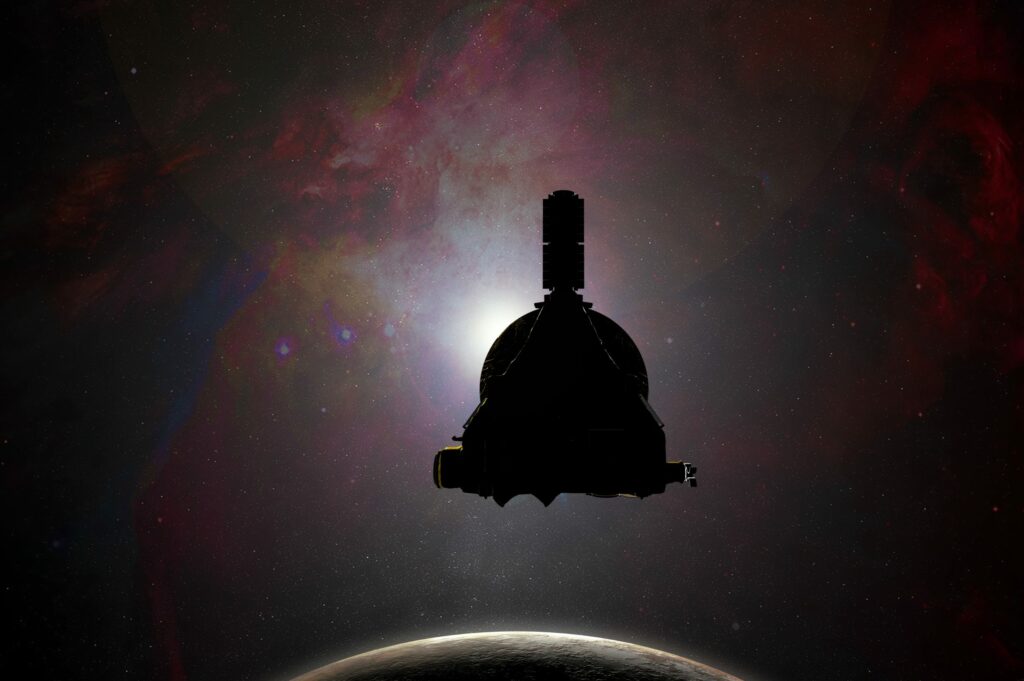
Perhaps, in time, the difficult story of the New Horizons mission will be turned into a plot for a movie.
From Pluto 350 to New Horizons
In the late 1980s and early 1990s, several groups of American scientists and engineers began preliminary development of concepts for a spacecraft that could be sent to Pluto. One of them was called Pluto 350. The project involved launching a probe weighing 350 kg. The group of developers included a young scientist Alan Stern, who later played a key role in the creation of New Horizons.

Unfortunately, during those years, NASA’s budget was significantly cut, and the administration was not ready to finance another major interplanetary mission. As a result, the participants of the Pluto 350 project began to consider the option of cooperation with Russia. One of the proposed ideas involved a Russian probe to on Pluto, which would be placed aboard the main apparatus. In 1994, Alan Stern, on his own initiative, came to Moscow for talks with the Space Research Institute of the Russian Academy of Sciences. But due to a number of reasons, that undertaking was futile. As a result, the Pluto 350 project was closed.
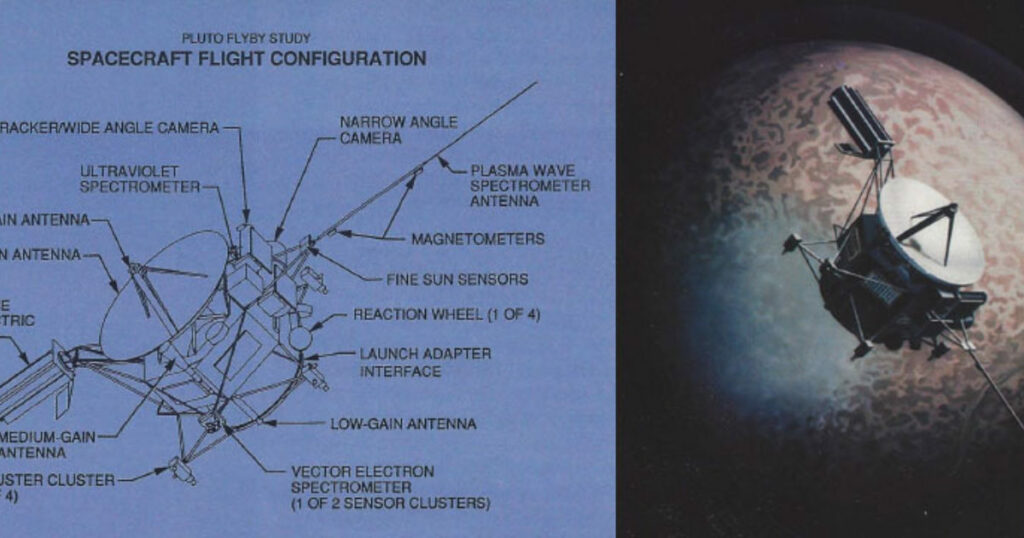
The situation began to gradually change in the late 1990s, when astronomers managed to confirm the existence of the Kuiper Belt, a remote region filled with a large number of icy bodies left over after the formation of the Sun and planets. Before beginning of the new century, researchers discovered a bulk of large trans-Neptunian objects similar in size to Pluto. It became clear that it is not “alone” at the edge of the solar system, being only one of the largest representatives of a whole class of bodies. All this significantly increased the interest of the scientific community and the public in sending a spacecraft to this unexplored region.
As a result, the NASA’s Jet Propulsion Laboratory (JPL) developed a new project called the Pluto Kuiper Express. The launch of the mission to Pluto was planned for 2004, but in 2000 NASA management canceled it due to the high cost.
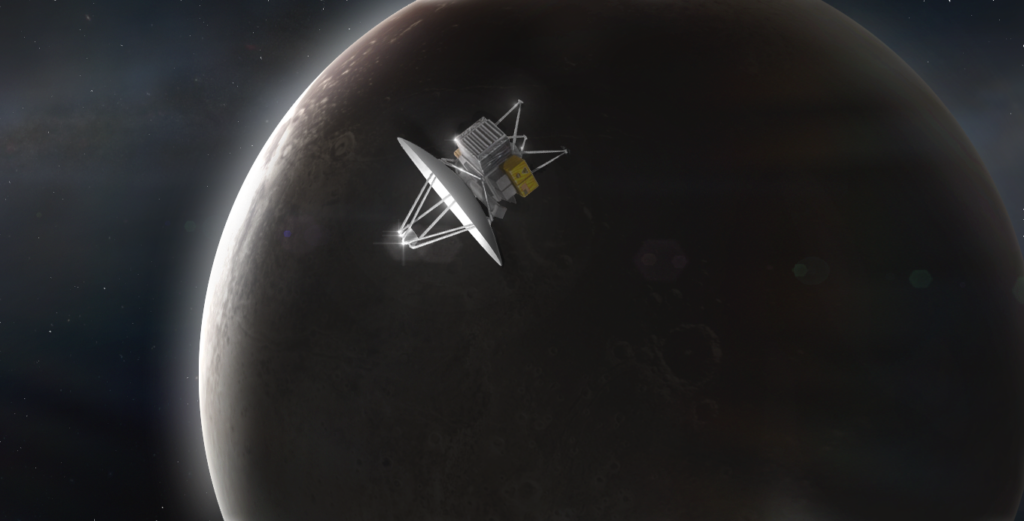
Later, Alan Stern took the stage again. Under his leadership, a team of researchers from the Johns Hopkins University Applied Physics Laboratory (APL) prepared an alternative mission project to Pluto, which was later named New Horizons. During its development, the main emphasis was placed on relative cheapness and short time of implementation. To reduce costs, the designers suggested using components and engineering solutions from previous NASA missions (in particular, Cassini-Huygens).
In 2001, the US National Aeronautics and Space Administration officially approved an expedition to Pluto, just in order to… cancel it again soon due to budget constraints. But the project participants did not agree with such a decision and launched a whole information campaign to explain the scientific importance of the research of objects in the Kuiper belt and the prestige of such a mission for the image of the United States. As a result, the government did allocate funds for the creation of the apparatus.
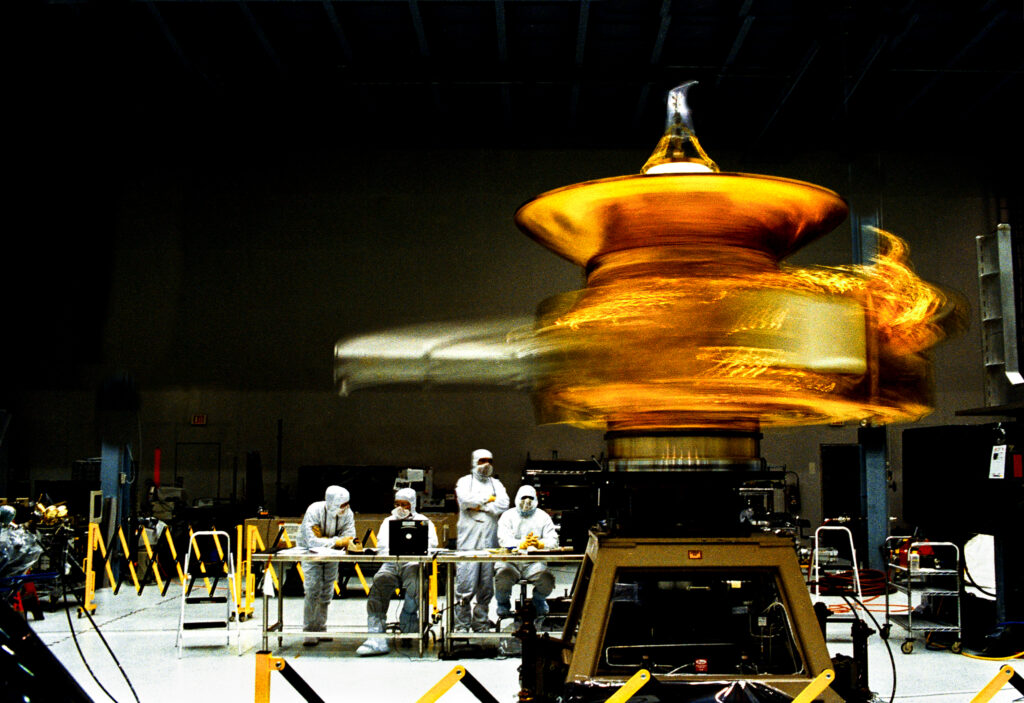
The dimensions of the New Horizons probe are 2.2 × 2.7 × 3.2 m, its initial mass (including fuel for on-board engines) was 478 kg. It is equipped with a suite of seven scientific instruments, which includes several cameras and spectrometers, a dust particle detector and a solar wind instrument. The device receives energy from the radioisotope thermoelectric generator (RITEG), which remained as a spare component from the Cassini mission.
Unlike the Pioneer and Voyager probes, NASA decided not to install any special messages for extraterrestrial civilizations on New Horizons. However, the designers placed on board a small collection of unique “souvenirs”: a pair of US flags, CDs with photos of the mission designers and the names of people who participated in the “Send Your Name to Pluto” campaign, a 1991 postage stamp with the inscription ” Pluto not yet explored” and a fragment of the first private spacecraft SpaceShipOne.
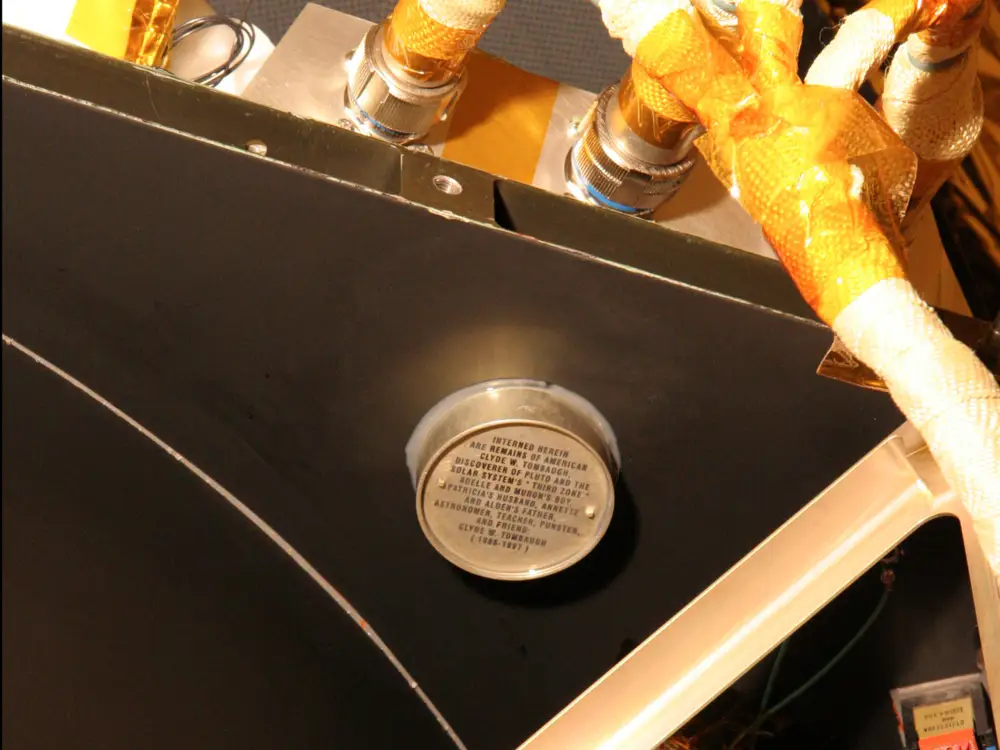
But the most symbolically pregnant item is the capsule containing a particle of ashes of the discoverer of Pluto, Clyde Tombaugh. Thus, the creators of the mission commemorated the famous astronomer, giving him the honor of becoming the first person buried in interstellar space. Also, two quarters were placed on board New Horizons — because during its journey the probe was supposed to visit Charon, so two coins can be considered a kind of payment for the transportation of Tombaugh’s soul.
A long way to Pluto
New Horizons was launched on January 19, 2006 by an Atlas V rocket. Interestingly, then Pluto was still considered the ninth planet — it was deprived of this status at the XXVI General Assembly of the International Astronomical Union, which took place in Prague in August of the same year.
At the time of launch, New Horizons set an important record — it left the outskirts of the Earth with the greatest speed ever (16.26 km/s). But even this was not enough to reach Pluto in an acceptable time frame. Therefore, the trajectory of the device was laid in such a way that it would make a visit to Jupiter and use its gravity for additional acceleration.
On its way to the gas giant, New Horizons made a long-distance flyby of asteroid 132524 APL. Engineers used this opportunity to test the spacecraft’s ability to track fast-moving objects.
The flyby of Jupiter took place in February 2007. During it, the device carried out complex observations of the gas giant, taking a number of impressive pictures of the planet and its largest satellites (including the eruption of Io’s volcanoes). Having completed this flyby, New Horizons was put into hibernation mode for a long time.
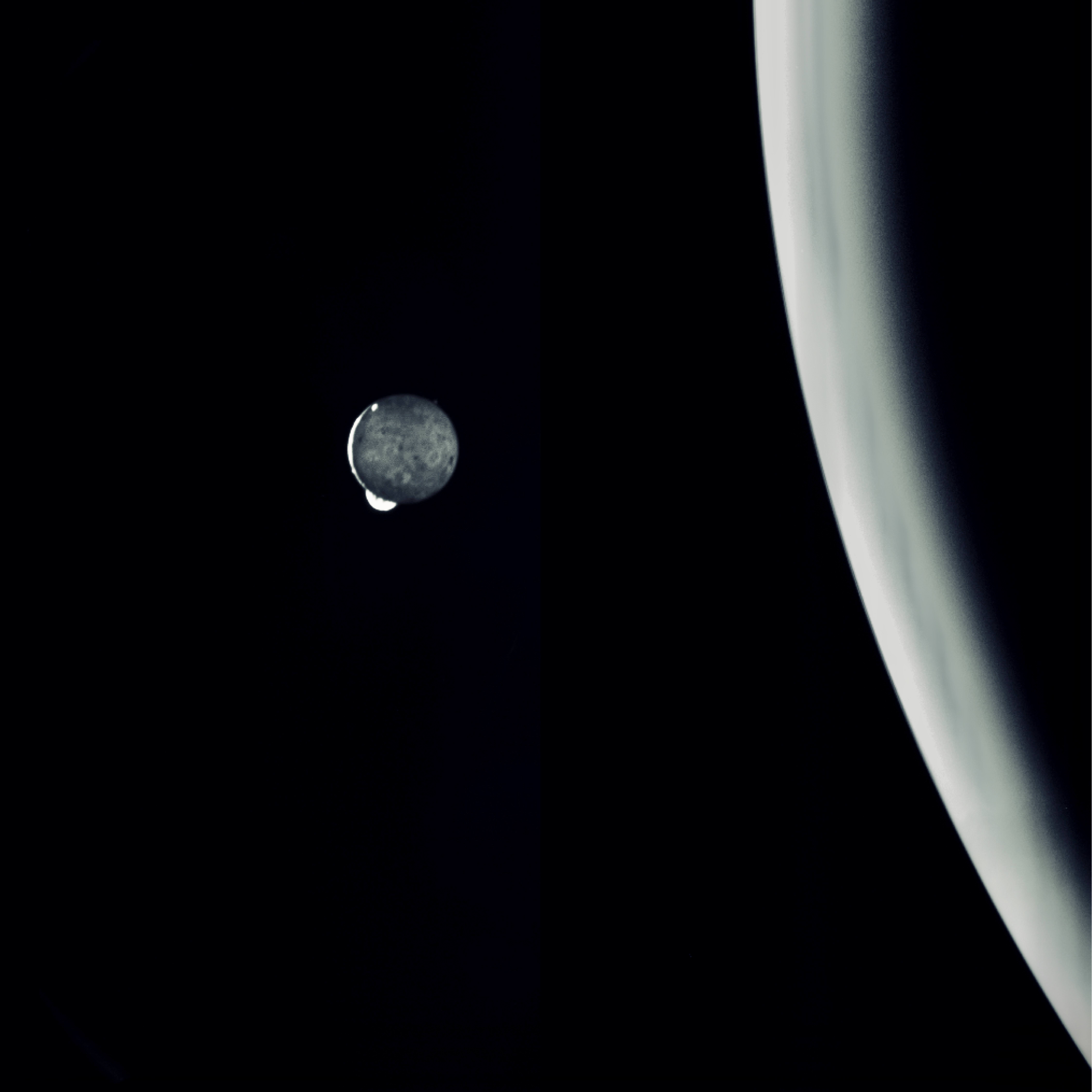
In early 2015, the probe began distant observations of Pluto. The purpose of this campaign was to clarify the position of the dwarf planet and its satellite family in order to lay the most optimal flight path. Another important task was the search for as yet undiscovered Plutonian satellites and/or rings. At that time, astronomers did not yet have enough information about the ex- ninth planet and assumed that it might be surrounded by rings or dust clouds, which would pose a potential threat to the mission. Actually, these apprehensions were not confirmed.
On July 4, 2015, ten days before the Pluto flyby, New Horizons‘ onboard computer unexpectedly went into safe mode, jeopardizing all planned exploration. Fortunately, the specialists of the support team were able to quickly determine the cause of the failure and restore the device’s operational efficiency. Therefore, this incident had minimal effect on the implementation of the scientific program.
Historic flight
On July 14, 2015, New Horizons passed at a distance of 12.5 thousand km from the surface of Pluto and 28.8 thousand km from Charon. After it had been confirmed that the device had successfully “survived” the approach and completed all the necessary measurements, a long period of retransmission of the data collected during the flyby began. It ended only at the end of October 2016. Such a significant period is explained both by the huge distance between the device and the Earth (almost 5 billion km), and by the technical limitations of the onboard equipment and the capabilities of the New Horizons transmitter.
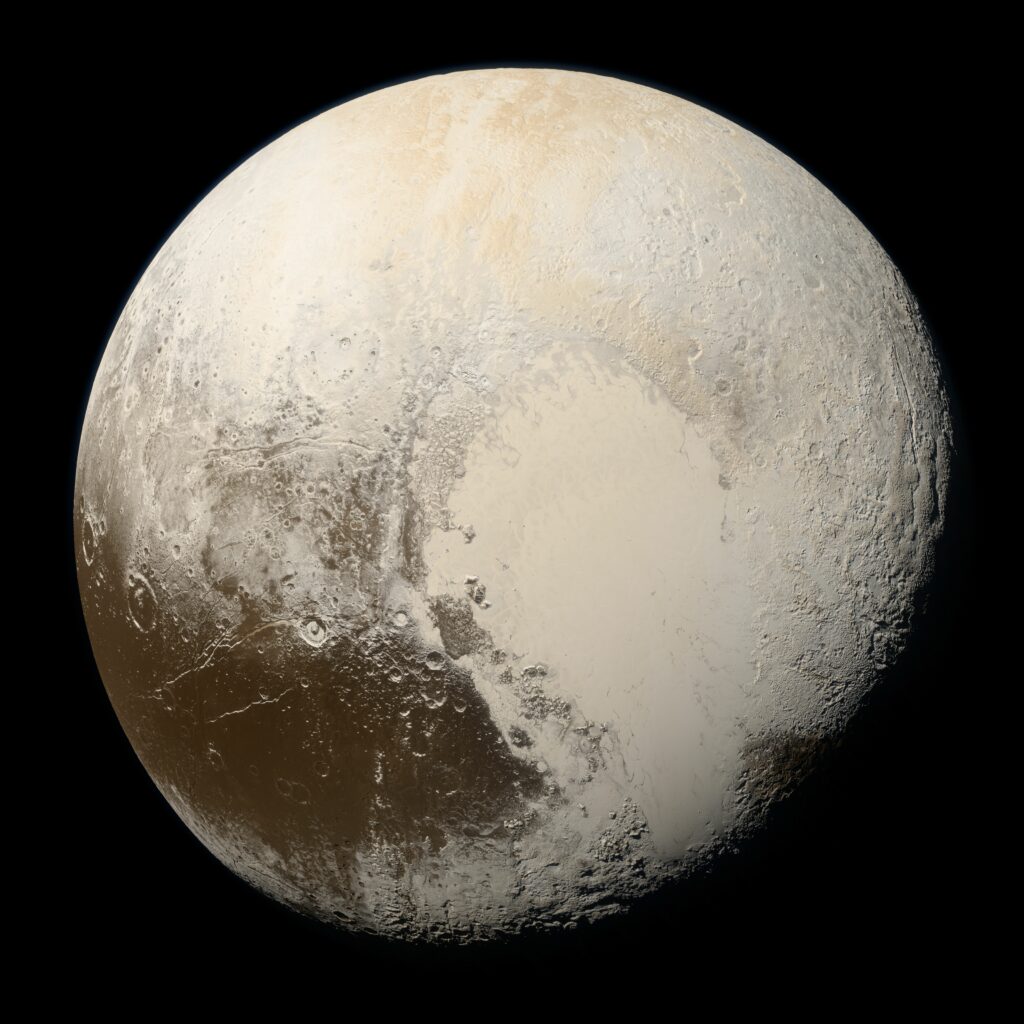
And the patience of scientists was rewarded generously. Pluto was previously thought to resemble the Neptunian moon Triton. But the first pictures from a close distance showed that this is not the case. The main distinctive feature of the dwarf planet is the “heart” — a huge bright region of a characteristic shape measuring 2,300 km. Its western part (Sputnik Platina) is one of the most amazing formations in the entire Solar System. It is covered with smooth nitrogen ice without any impact crater, which indicates its exceptional youth. The plain is surrounded by mountains that consist of water ice (at the temperature of Pluto’s surface, it actually plays the role of rocky ground).
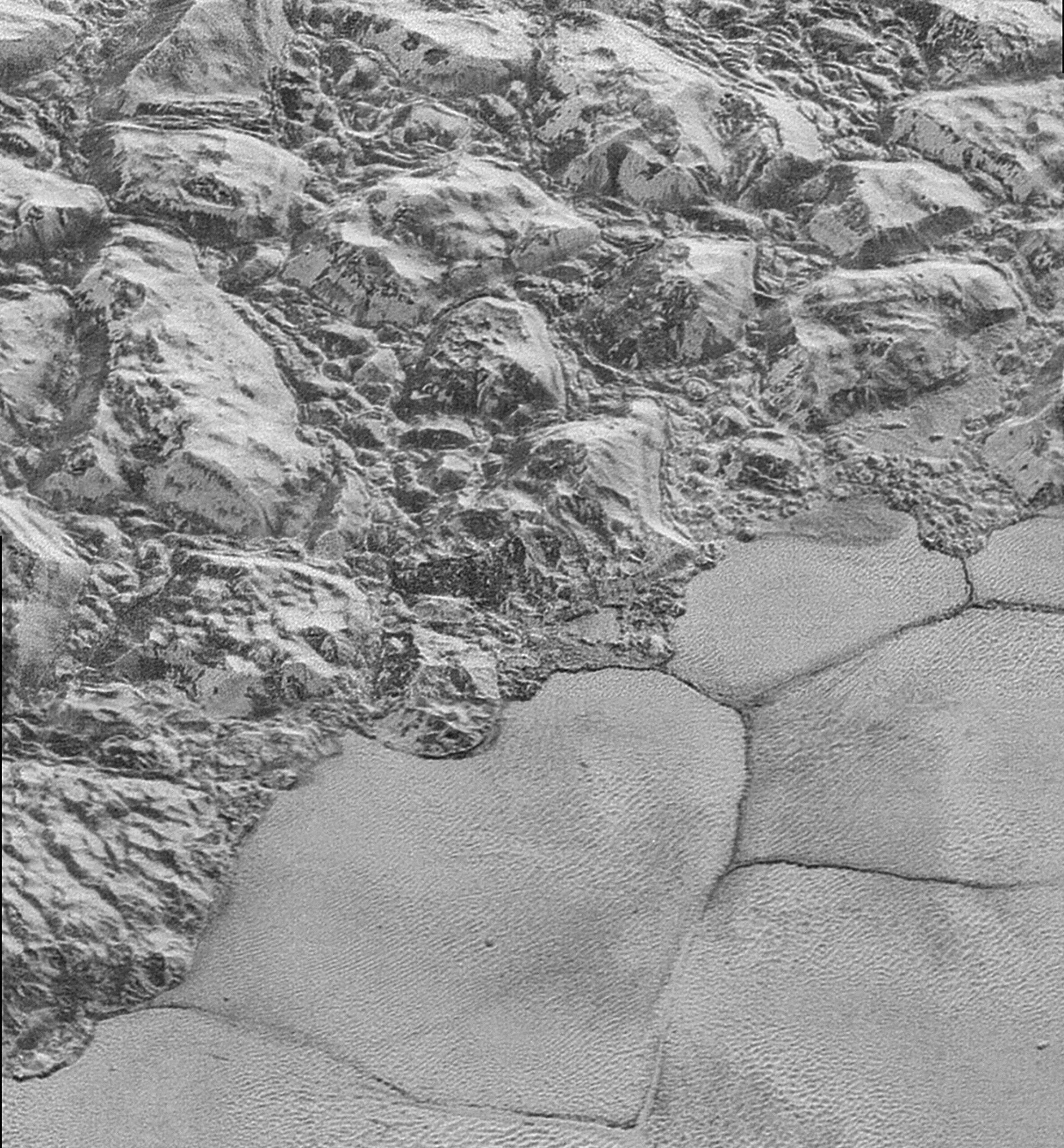
According to the researchers, the “heart” is actually a huge impact crater that was filled with nitrogen and other frozen volatiles over time. New Horizons images show that this region is covered by a kind of slabs of nitrogen ice. It is believed that the nitrogen under them is in a liquid state. When it comes to the surface, it freezes and forms new slabs. Over time, they sink under each other and melt, after which the process repeats itself. It’s like a giant “lava lamp” that constantly renews the surface.
Another amazing feature is the “icebergs” — blocks of water ice found on the Sputnik Platina. It seems that they periodically break away from the surrounding mountains. However, the speed of their movement is small and is only a few centimeters per year.
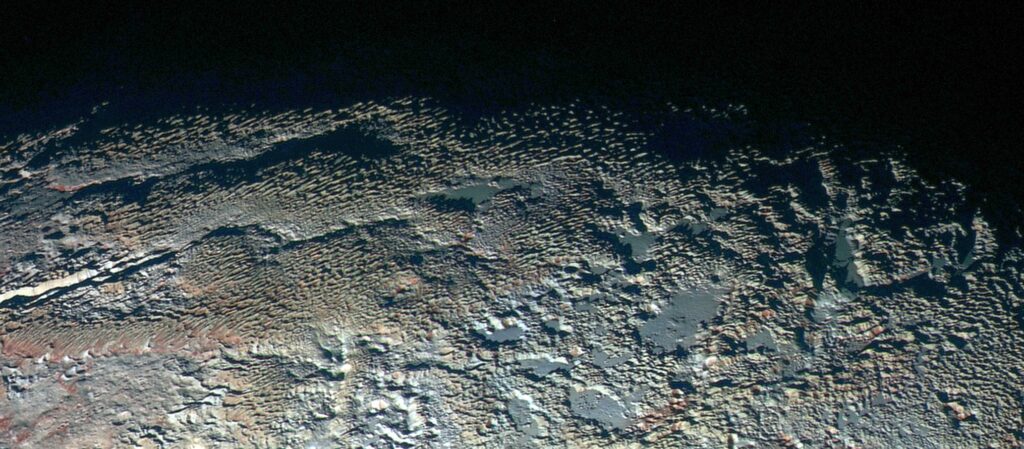
But the Sputnik Platina is far from the only attraction of the dwarf planet. New Horizons was also able to photograph unusual “jagged” areas covered with characteristic ice formations that look like blades or needles up to 500 m high. They are usually located in rows with an interval of 3-5 km. These needles are formed due to freezing of methane out of the plutonian atmosphere.
Pluto also has mountainous and heavily cratered regions. New Horizons images showed that their highest areas are covered with methane snow, while in the lowlands there are valleys — a mixture of complex organic molecules formed in a nitrogen-methane atmosphere under the influence of solar radiation.
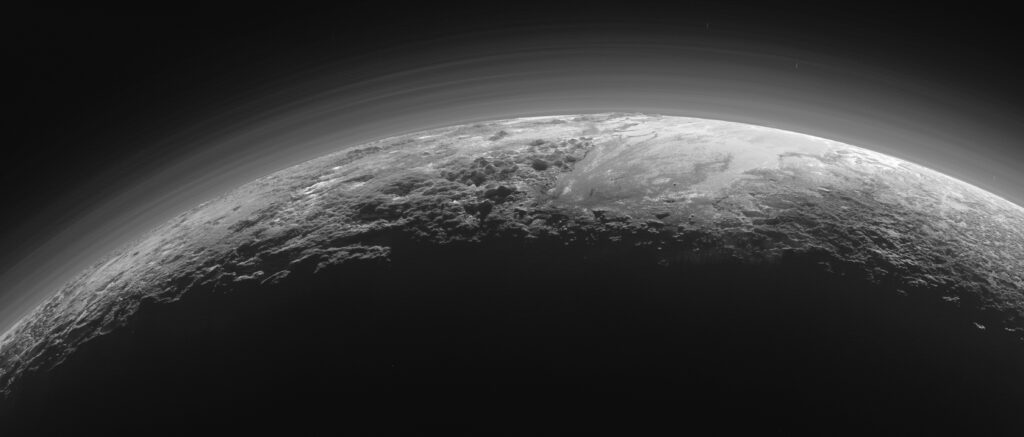
Valuable data were also fetched about the gas shell of the dwarf planet, which turned out to be much more complex than scientists thought. New Horizons discovered that it consists of many layers of hydrocarbon haze. At the same time, despite its extreme rarity, winds blow there, noticeably affecting processes on the surface. One of the most beautiful images was taken when the Sun was behind Pluto and shining through its atmosphere, creating a halo of beautiful blue haze.
Charon also gave scientists a few surprises. It turned out that a gigantic system of canyons stretches along the equator of this celestial body, down to 9 km in depth. Probably, their total length may even exceed the length of the famous Valleys Marineris on Mars. Most likely, Charon once had a subsurface ocean. When it froze, it caused the interior of the satellite to expand, causing its crust to crack.
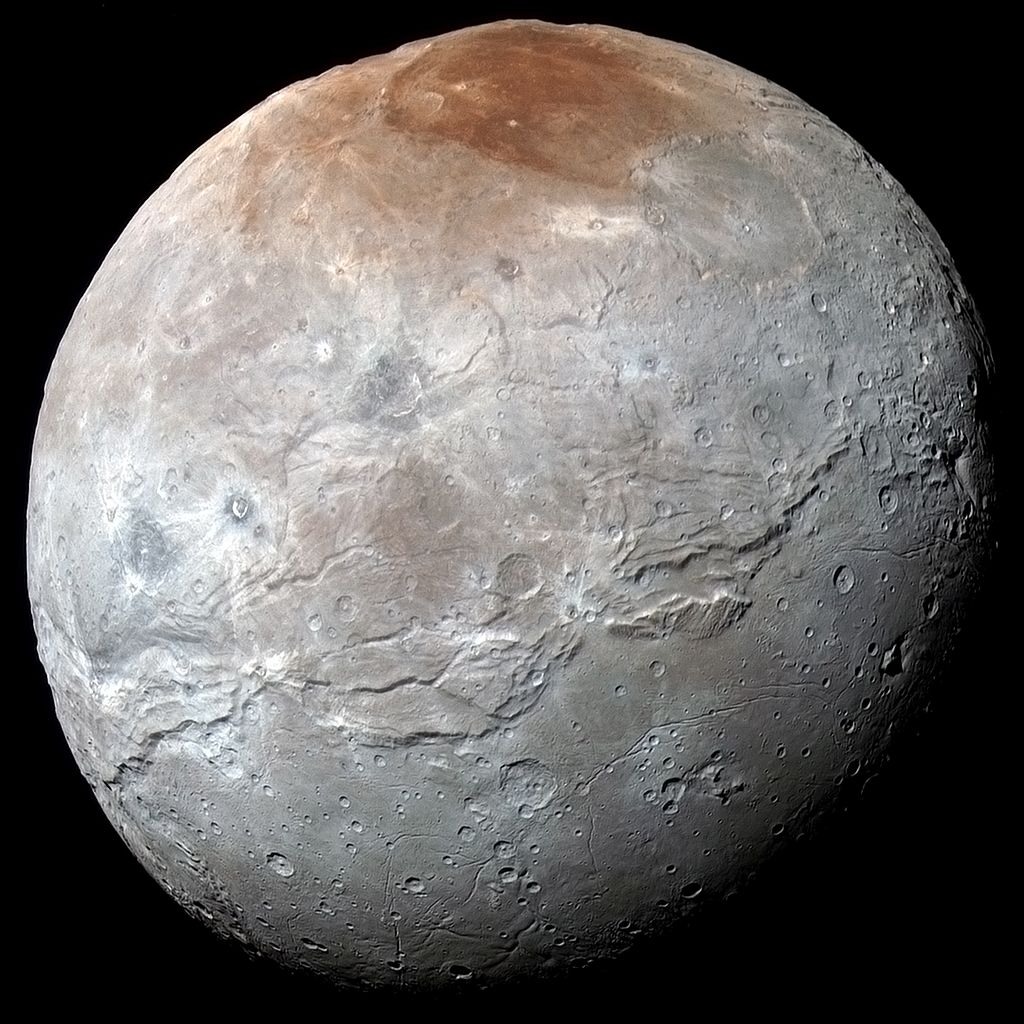
Another unusual feature of Charon is the mountains that literally grow out of the depressions. It is assumed that their origin is related to cryovolcanic activity, but the mechanism of the appearance of these structures still remains a mystery to scientists.
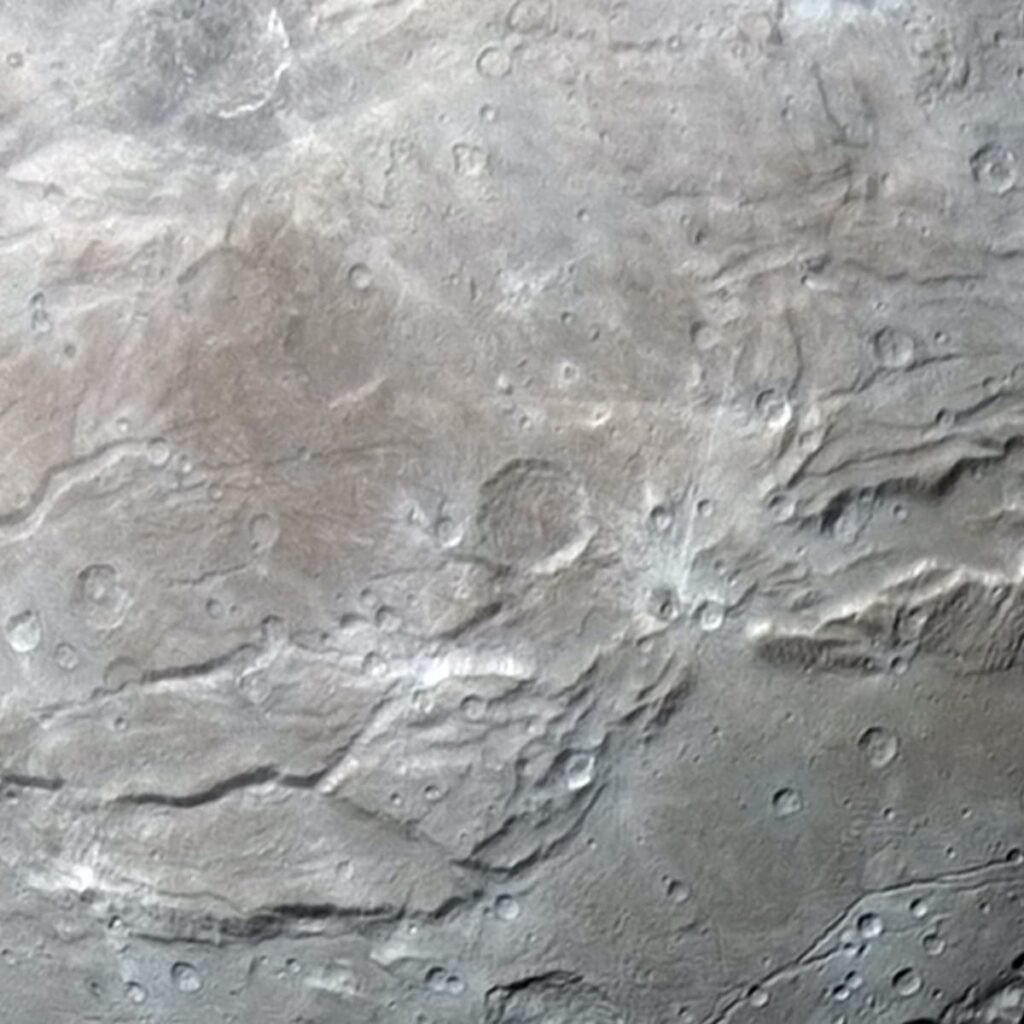
Summing up the results of the Pluto flyby, perhaps, the main discovery of the mission was that even a cold body so distant from the Sun can retain endogenous activity these days. More and more researchers are tend to assume that an ocean of liquid water may still exist in the bowels of the dwarf planet. And this means that the search area for extraterrestrial life is much wider than previously thought.
Deep into the Kuiper belt
After the Pluto flyby, New Horizons began an extended part of its mission — the study of the Kuiper Belt. Its main goal was to make a close flyby of some distant object “happening” to be there. However, the search for such a body turned out to be quite a difficult task, which even the most powerful ground-based observatories could not cope with. As a result, the project management decided to use the Hubble telescope. After a long search, astronomers managed to identify several suitable kuiperoids near the further trajectory of the probe. The chosen one is the object 2014 MU69, later named 486958 Arrokoth.
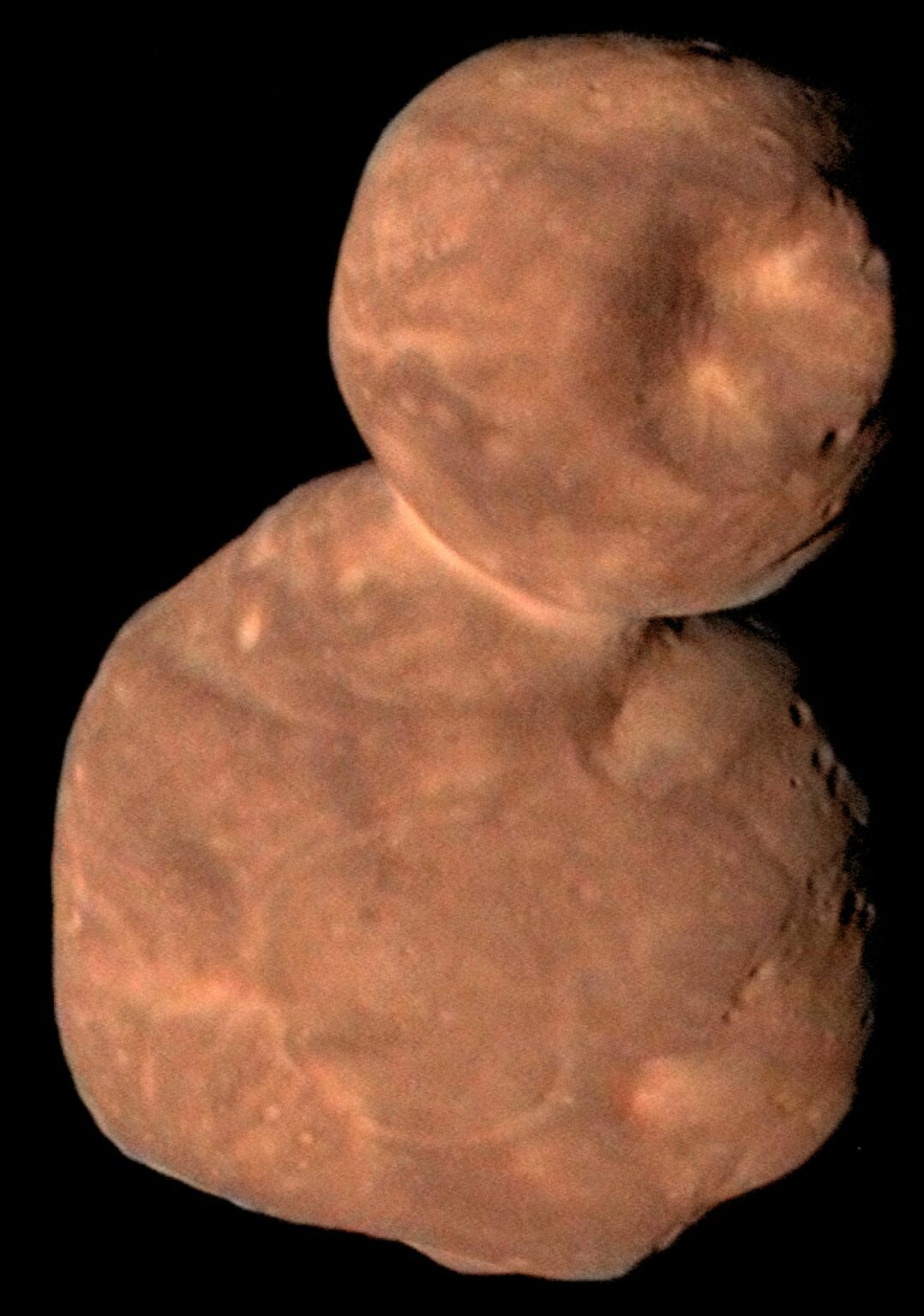
New Horizons visited Arrokoth on January 1, 2019. The flyby again presented a lot of interesting things. The kuiperoid turned out to have little resemblance to known asteroids and comets. The transmitted images showed an unusual world measuring 36×20 km, consisting of two flattened spheres connected by a thin isthmus. According to astronomers, Arrokoth is the “most primitive” body in the Solar System that has ever been visited by an automated vehicle.
The surface of the koiperoid is reddish and covered with methanol ice, as well as more complex organic molecules. Its average temperature is -244±5°C. Arrokoth is supposed to be formed as a result of a low-velocity collision between two objects that occurred shortly after our planetary system began to form.
Analysis of the Arrokoth images revealed several craters. The diameter of the largest of them is 7 km, the rest are sub-kilometer in size. Taking into account the total number of impact formations, astronomers estimated the age of the surface of the kuiperoid at 4 billion years. Considering the fact that the object’s orbit is close to a circular one, we can safely assume that it has remained practically intact since the “youth” of the Solar System and was almost not exposed to serious external influences after its formation.
After the Arrokoth flyby, New Horizons continued its journey deep into the Kuiper Belt. Currently, the device is used for remote observations of trans-Neptunian objects, as well as for various experiments. For example, the probe recently measured the distances to the stars closest to the Sun.
The mission team hopes to find another Kuiper Belt object to target New Horizons in the future. In the summer of 2020, the ground-based Subaru telescope was involved in the search. It is worth noting that the chances of finding a “suitable” koiperoid are not very high. The fact is that the spacecraft has already passed most of the belt and, moreover, has spent a lot of fuel, which is significantly reduces the possibility of changing its trajectory.
However, even if Subaru is unable to find a suitable object, New Horizons will not stay unemployed. It will continue remote observations and will also perform measurements of environmental characteristics. According to engineers, his RITEG will produce enough energy to continue operating until at least the early 2030s.
Potential future missions to Pluto and the Kuiper Belt
Discoveries made by the New Horizons probe have ignited scientific interest in the Kuiper Belt. If a sub-ice ocean is possible on Pluto, we can expect the same on other large trans-Neptunian objects. But the only way to test this assumption is to send new missions there.

Unfortunately, this is not easy to do. The main problem is time. Even with a successful arrangement of the planets, which will allow the use of gravitational acceleration, the journey along the flyby trajectory will take a decade at least. If we are talking about a mission with entering into a permanent orbit, then the term of its implementation grows up to several decades. And this greatly complicates the preparation of such a project and reduces the chances of its approval.
An example is the recent concept of a new mission to explore Pluto, developed by a group of engineers, many of whom participated in the creation of New Horizons. It involves the launch of a device that will be put into orbit around a dwarf planet with the possibility of further departure to other objects in the Kuiper belt. To achieve this goal, the authors of the project propose to use a combination of a super-heavy launch vehicle like the SLS, a series of gravity maneuvers, as well as a nuclear electric stage supplemented by a module with a traditional chemical engine.
The proposed flight scheme looks as follows. Launched in 2028, the device will make the first flyby of Pluto in 2046. It will then perform a series of braking maneuvers using both its own engines and the dwarf planet’s gravity. By 2059, the automatic probe will have completely extinguished its orbital velocity, allowing it to enter a permanent Plutocentric orbit. After completing the main mission, the probe will be able to leave the vicinity of Pluto and will be directed to another Kuiper belt object.
According to rough estimates, the implementation of such a project will cost billions of dollars, which is an order of magnitude more than the cost of New Horizons. Now it seems unlikely that NASA will fund such a mission.
As for more “prudent” options, it is worth mentioning the Trident project, developed by a team of engineers from JPL. According to the authors’ idea, the mission architecture should be based on the main engineering solutions of New Horizons, which will allow to significantly reduce the costs of its implementation.
The goal of the project is to study Triton. Yes, formally it is a satellite of Neptune, but all the available data indicate that in the distant past this body was a Kuiper belt object, at some point captured by the gravity of the eighth planet. The flight plan envisages the launch of an automatic device in 2025, a gravitational maneuver in the vicinity of Jupiter in 2032 and a flyby of Triton in 2038. The timing of the visit is specially chosen so that the probe can map the entire surface of the satellite. Astronomers also hope that it will find out characteristics of the Tritonian subsurface ocean.
Then the device will continue its pilgrimage deep into the Kuiper belt. Therefore, it is likely that, like New Horizons, it may eventually be directed to some suitable object near its initial trajectory.
Trident is one of the four projects of interplanetary missions that made it to the finals of the regular selection under the Discovery program. It has a good chance of winning. NASA experts are already analyzing the applications. The winner will be announced at the end of this year.
So, even under the most favorable scenario, a new space mission will not reach the Kuiper belt until the end of the next decade. So the New Horizons voyage was effectively a once-in-a-generation flight. Understanding this, you begin to appreciate even more the efforts of scientists and engineers, who managed to realize this mission. Otherwise, we would still be ignorant about Pluto’s face, not to mention the presence of its “heart” and “blood” (an entire ocean may be hiding deep inside).

